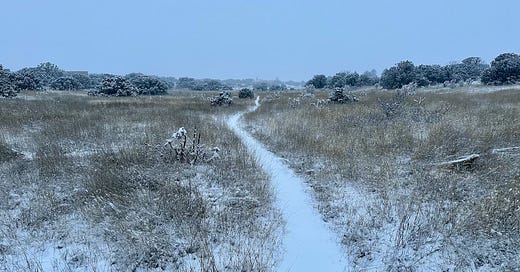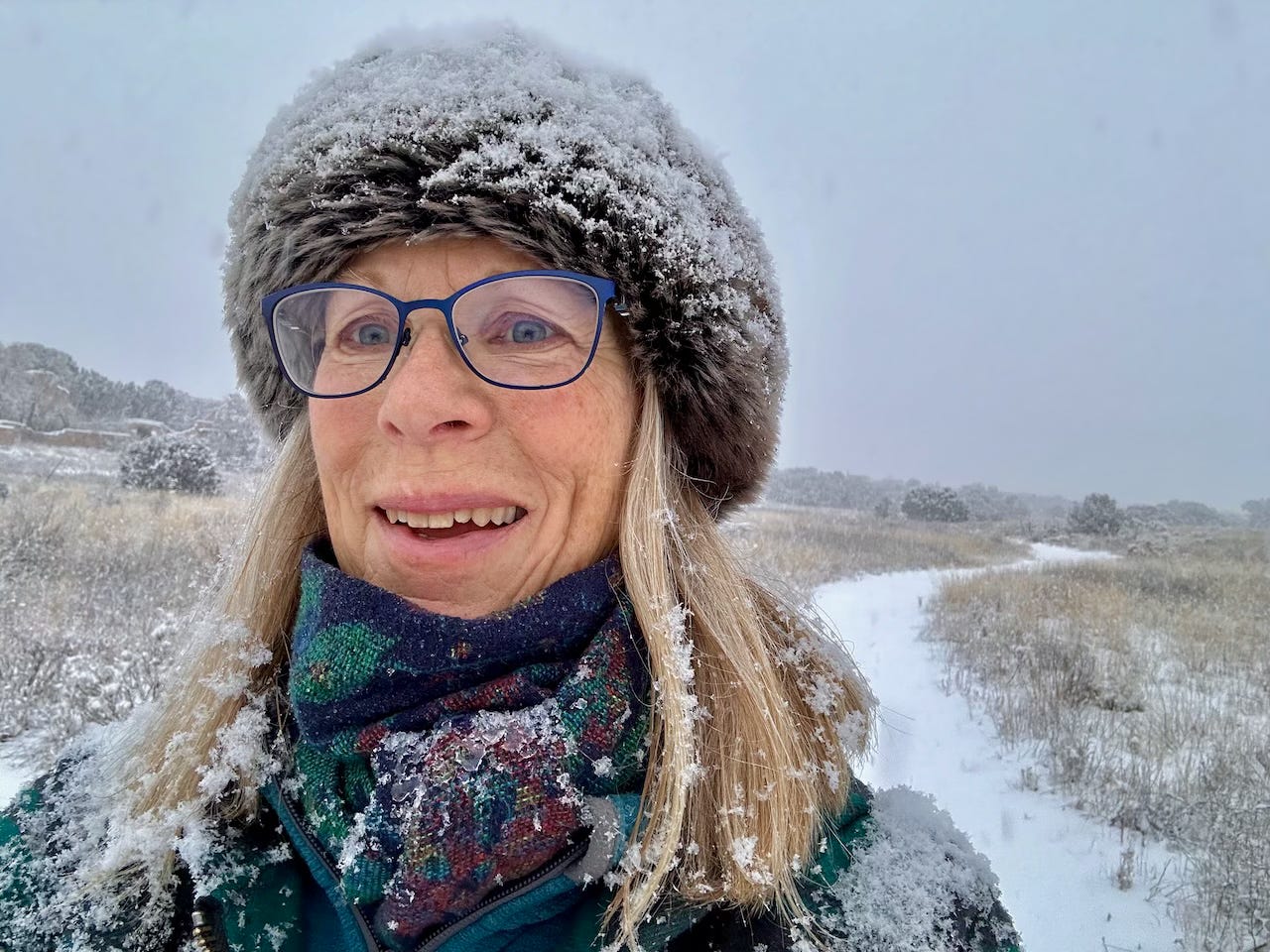This morning at dawn, I walked the draw below my house in a steady rain of falling snow, with several soft inches already on the ground. And I thought about an ongoing discussion I’ve had for many years with my friend Dr. Dawn Wink, an extraordinary gifted author and teacher, about how language defines landscape, and landscape defines language. This morning, I pondered the terms for the shallow drainages that have provided my daily walking routes since I returned to New Mexico last winter and how those terms shape my understanding of these landscapes.
At my condo in the foothills, I walked an arroyo every morning. An arroyo is a streambed that is usually dry, sometimes with steep sides, and with a wide sandy or rocky bottom that stays clear of plants because during spring snowmelt or after summer rains, water may flow down it in a torrent, carrying enough sediment to grind the soil clean. In my favorite encyclopedia of landscape terms, Home Ground: Language for an American Landscape, edited by the late Barry Lopez and his wife, Debra Gwartney, Arturo Longoria writes that the word arroyo comes from the Spanish word for creek, even though these creeks are most often dry on the surface.
Here on the edge of the Southern Plains at the house I moved to earlier this month, I walk a very different sort of usually dry watercourse: a draw. A draw, Conger Beasley, Jr., writes in Home Ground, “is a small natural watercourse or gully, shallower and more open than a ravine or gorge [and I would add, or an arroyo]; also known in some areas as a blind creek… A draw is typically dry and subject to flooding in heavy rains.” The draw below my house is shallow, thickly vegetated with a blue grama grassland, and studded with the darker polka-dots of short one-seed junipers and a few piñon pines. (That’s the draw in this morning’s snow in the photo at the top of the post.)
Why does it matter that I call this shallow, grassy declivity in the rounded edge where the plains meet the mountains a draw rather than an arroyo? To some people it doesn’t. To them, the landscape feature I am getting to know is likely a mere blip in a featureless expanse. But to me, it is home. And I want to be able to know it intimately, to gain, as Lopez writes in the Foreword to Home Ground, “[T]he comfort that a feeling of intimate association with a place can bring….”
I see this house as my final one for what a friend of mine calls the “home stretch” of our lives, the few decades remaining in my allotted span. (If I am fortunate in how long I live; as the widow of a vigorous, healthy man who died of brain cancer at age 61, I am well aware that there are no guarantees to the span of our lives.) This house and this landscape are my chosen place, and I want to know them in a way that respects their individuality.
Thus, my interest in describing the shallow, grassy valley traced by the trail I walk more specifically than the generic term valley. It is a draw, a classic dry watercourse of the western Great Plains. I want to know its particulars: who lives here in addition to the shrubby junipers, the semi-circles of blue grama grass, the singing coyotes and the sapphire-backed western bluebirds. How their lives interweave. How the draw changes through the seasons.
I look forward to the surprises I find on my daily dawn walks, whether they be wet snow coating me and the landscape, the roaring sweep of winter winds, or the first flush of green come spring.
In short, I want to know this place in a way that says I belong: me to the place, the place to me. Belonging does not imply possession, more a relationship that expresses my terraphilia, born of familiarity and respect. I want my existence here to honor all the place is, and to be part of its interwoven community of lives.
What specific term(s) would you use to describe the landscape where you live? Do they conjure the spirit of the place as you understand it? Hit the “comment” button below and let me know!
Thanks for reading Practicing Terraphilila, and supporting my work! I write these occasional Thursday pieces specifically for you, my paying subscribers, because I want to thank you for your belief in me and my writing. This writing is my gift to you. If you are so moved, you are welcome to share it with others. Spreading the word is another way of supporting my writing, and I greatly appreciate it and you! Blessings.






As you know, our landscape goes from lower to higher to much higher. My office window faces lower slopes and mountain tops. I love your descriptions of the draws, arroyos, canyons, and even drainage ditches. I envy your early morning walks and enjoy every haiku and photograph. I spend much time watching and enjoying our lush high desert foliage: sagebrush with its almost green leafy branches and stalks of amber seeds, rabbitbrush turned to cottontails in the fall, great basin rye with its pale yellow blades, empty aspen branches still clinging to bits of dark brown leaves, purple doc, a tall skinny beige mullein. Our birds in late fall are limited to chickadees, juncos, blue and white magpies, and, if we're lucky, a northern harrier or red-tailed hawk. The Asian doves visit the railing on our front porch from time to time and our cat Buttercup squeaks. And now, as I write, a soft wind is stirring every plant so they shudder back and forth. Low white spots of snow vary the fall vista. I have on my corkboard this somewhat edited quote from Wallace Stevens: After all, they know that to be real each had/To find for herself, her earth, her sky, her sea.
Thanks for this Thursday Bonus, dear Susan. I look forward to being drawn into your draw many more times as you learn all about it in its various seasonal permutations.